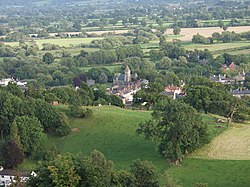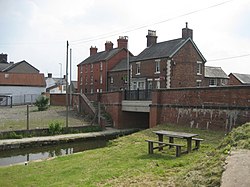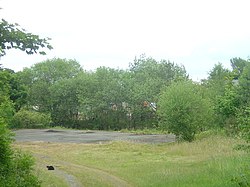Llanymynech
| Llanymynech | |
| Montgomeryshire, Shropshire | |
|---|---|
 Llanymynech viewed from nearby Llanymynech Hill | |
| Location | |
| Grid reference: | SJ266209 |
| Location: | 52°46’52"N, 3°5’20"W |
| Data | |
| Population: | 887 |
| Post town: | Llanymynech |
| Postcode: | SY22 |
| Dialling code: | 01691 |
| Local Government | |
| Council: | Powys, Shropshire |
| Parliamentary constituency: |
Montgomeryshire, North Shropshire |
Llanymynech is a village and ancient parish straddling the border between Montgomeryshire and Shropshire, about nine miles north of Welshpool. The Montgomeryshire part of the village additionally falls within a detached part of Denbighshire. The name is from the Welsh language for "Church of the Monks". The village is on the banks of the River Vyrnwy, and the Montgomery Canal crosses through it.
The border runs for the most part down the centre of the village's main street, with the eastern half of the village in Shropshire and the western half in Montgomeryshire. The border also passed right through the now-closed Lion pub, which had two bars in Shropshire and one in Montgomeryshire. At one time Welsh counties were referred to as "wet" or "dry" depending on whether people could drink in pubs on Sundays. When Montgomeryshire was dry it was legal to drink on Sundays in the two Shropshire bars of the Lion but not the Montgomeryshire bar. Two of the remaining open pubs in the village are entirely in Shropshire and the third is entirely in Montgomeryshire.
The parish church lies just on the Shropshire side, although both parts of the village lie in the same ecclesiastical parish, Llanymynech in the Diocese of Lichfield.
Just to the north of the village is Pant. Further north is the market town of Oswestry.
History
Llanymynech Hill is one of Wales' earliest mining sites. Evidence suggests that copper was mined and smelted here in the late Bronze Age, and that ores were used for the manufacture of bronze weapons and other implements.[1] The hill above Llanymynech is crowned with an extensive Iron Age hill fort, which extends over 140 acres and surrounds a cave opening known as the Ogof.[2] The magnitude of this hill fort is probably explained by the presence of the copper mines. The hill fort would have served as protection for the mine, and housed the labourers employed in the extraction of copper.
The Bronze Age British miners would have used fire-setting mining techniques, but with the arrival of the Romans the cavern was extended and more extensively mined.[3] According to the Clwyd Powys Archaeological Trust, before the hill was landscaped for the current golf course, at least ten shafts were visible on the southern part of the hill, together with a large number of shallow pits and shaft-mounds. The main entrance to the mine is still the Ogof. A number of Roman artefacts have been found in the mine including a number of bones and burials, and a hoard of thirty first and second century silver coins of Roman currency found in 1965 by some schoolboys, now conserved at the National Museum of Wales. The mine was probably abandoned c. AD 200.
In early mediæval times, Offa's Dyke was built c. AD 780 through what is probably the main street in Llanymynech, on the east side of the road. It is thought the west wall of St Agatha’s churchyard was built on the raised part of the dyke.[3] Today, the Offa's Dyke Path passes through the village.
Under the Normans, the town came under the rule of the Lord of the March, and a fortification called Carreghofa Castle was built by the Earl of Shrewsbury around 1101.[3] The position the castle was (probably) built, at Tanat Camp, just to the west of Llanymynech Hill and overlooking the Tanat valley, implies it was defending the hill which was being mined for copper and lead, as well as silver. Being situated directly on the borderlands, the castle changed hands between the English and Welsh numerous times during the 12th and 13th centuries. In 1187 the castle was captured by Owain Fychan, prince of Powys, who was then murdered at the castle by his cousins Gwenwynwyn and Cadwallon.[4]
In 1194, the castle was recaptured by the English with the purpose of re-opening the mines on Llanymynech Hill and extracting silver. Richard I had been captured and held for a ransom of £100,000, and the Bishop of Salisbury, Hubert Walter, heard of the discovery of silver at the Carreghofa Mine on Llanymynech Hill; he decided to develop the mine and re-open the mint at Shrewsbury to refine the silver and make it into coins. Unfortunately, the total amount of silver produced only came to the value of £20, 11 shillings and 11 pence. This mine was located north of the present quarry, and just south of the present golf course clubhouse. In the 1230s, the castle was destroyed and the stones were eventually removed and used to construct nearby Carreghofa Hall. Very little remains of the castle today.[3]
Features
Llanymynech hill is now the site of Llanymynech Golf Club perched atop the cliffs, whose 18-hole course again straddles the county border.
The village is home to one of only three remaining Hoffmann kilns in the British Isles, and the only one with a chimney. The kiln at Llanymynech was used for lime burning. The area around the kiln is designated as Llanymynech Heritage Area.
The former limestone quarry which fed the kiln is now the Shropshire Wildlife Trust's Llanymynech Rocks Nature Reserve and its cliff-face is popular with rock climbers.
Transport

Due to the local lime stone and mineral deposits, Llanymynech became a transport hub.
First to arrive was a branch of the Ellesmere Canal, where it joined the Eastern section of the Montgomeryshire Canal at Carreghofa. Today the canal is known as the Montgomery Canal, and the section through Llanymynech is isolated, with a ½-mile section being navigable to boats. To the north to Pant the canal is dry; to the south the canal is isolated by lowered bridges. A campaign is in hand, to restore the canal to through traffic.
The main line of the Oswestry and Newtown Railway (O&NR) arrived from the south in 1860, a later constituent part of the forming of the Cambrian Railways. In 1863, the Cambrian completed the construction of the Llanfyllin branch, a railway constructed to enable distribution of minerals in competition with the canal. Stipulated in the authorising Act of Parliament to avoid flat crossing of the existing canal and Tanat Valley Light Railway, bridges had to be constructed to enable operations.
The later Potteries, Shrewsbury and North Wales Railway (Potts), which ran to Shrewsbury Abbey station, originally ran under the O&NR and the canal to enable the Nantmawr branch for similar mineral extraction purposes. However, after it ran into financial difficulties, the CR took over the Nantmawr branch, agreeing to rebuild the southern end of the Potts so that it now junctioned through Llanymynech.
After failing to junction with the GWR and the LNWR at Shrewsbury, the S&NR suffered from low traffic and continual financial difficulties, having now also lost its main revenue stream from the Nantmawr branch. Taken over by the GWR in the Railways Act 1921, it was closed again to passengers on 6 November 1933, but remained open as a military freight route until 1960.
The CR mainline from Whitchurch to Welshpool (Buttington Junction), via Ellesmere, Whittington, Oswestry and Llanymynech, closed on 18 January 1965 in favour of the more viable Shrewsbury and Hereford Railway route. This also resulted in the closure of the Llanfyllin branch. The Nantmawr branch remained in operation until 1998, with the track from Oswestry still in place today.
Although railways presently do not serve Llanymynech, both the Cambrian Heritage Railways and the enthusiast-revived TVLR plan to reconnect Llanymynech with their heritage railway schemes.
The A483 trunk road is the main road through the centre of Llanymynech.
References
- ↑ Wilcock, John. "Llanymynech Copper Mines". Understanding pre-industrial structures in rural and mining landscapes. European Cooperation in the Field of Scientific and Technical Research. http://www.fcet.staffs.ac.uk/jdw1/llanymynech.html. Retrieved 23 October 2013.
- ↑ Davies, John (1990/2007). A History of Whales. London: Penguin Books. p. 18. ISBN 978-0-14-028475-1. http://www.amazon.com/A-History-Wales-John-Davies/dp/0140284753.
- ↑ 3.0 3.1 3.2 3.3 Rhodes, Neil. "Chapter 2: The Romans". On the Border: The Story of Llanymynech and Pant. Neil Rhodes. http://www.llanymynechandpant.co.uk/ch02.html. Retrieved 23 October 2013.
- ↑ Mersey, Daniel. "Carreghoffa Castle". Castles of Whales. Jeffrey L. Thomas. http://www.castlewales.com/carreg_h.html. Retrieved 23 October 2013.
Outside links
| ("Wikimedia Commons" has material about Llanymynech) |
